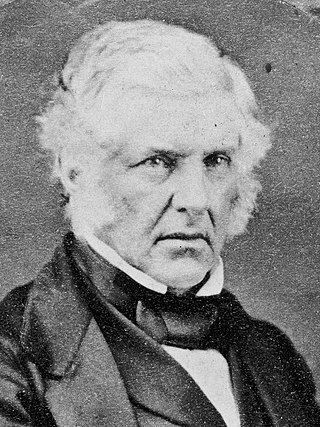Notes
- ↑ "Election Notice". Taranaki Herald . 15 June 1861.
| | This New Zealand election-related article is a stub. You can help Wikipedia by expanding it. |
The 1861 Grey and Bell by-election was a by-election held on 20 June during the 3rd New Zealand Parliament in the Taranaki electorate of Grey and Bell.
The by-election was caused by the death of the incumbent MP William Cutfield King on 8 February 1861.
The by-election was won by Harry Atkinson.
Atkinson was unopposed, and was duly declared elected. [1]

The provinces of the Colony of New Zealand existed as a form of sub-national government. Initially established in 1846 when New Zealand was a Crown colony without responsible government, two provinces were first created. Each province had its own legislative council and governor. With the passing of the New Zealand Constitution Act 1852 the provinces were recreated around the six planned settlements or "colonies". By 1873 the number of provinces had increased to nine, but they had become less isolated from each other and demands for centralised government arose. In 1875 the New Zealand Parliament decided to abolish the provincial governments, and they came to an end in November 1876. They were superseded by counties, which were later replaced by territorial authorities.

Sir Harry Albert Atkinson served as the tenth premier of New Zealand on four separate occasions in the late 19th century, and was Colonial Treasurer for a total of ten years. He was responsible for guiding the country during a time of economic depression, and was known as a cautious and prudent manager of government finances, though distrusted for some policies such as his 1882 National Insurance (welfare) scheme and leasehold land schemes. He also participated in the formation of voluntary military units to fight in the New Zealand Wars, and was noted for his strong belief in the need for seizure of Māori land.

Sir Francis Dillon Bell was a New Zealand politician of the late 19th century. He served as New Zealand's third Minister of Finance, and later as its third Speaker of the House. The town of Bell Block near New Plymouth – on land Bell bought from the Puketapu iwi in 1849 – is named after him, as is Bell Street, Whanganui. Bell's son, Francis Henry Dillon Bell, became the first New Zealand born Prime Minister in 1925.
Charles Brown was a New Zealand politician from the Taranaki area.

James Crowe Richmond was a New Zealand politician, engineer, and an early painter in watercolours of the New Zealand landscape.
Taranaki was a New Zealand parliamentary electorate that existed for three periods between 1881 and 1996. It was represented by nine Members of Parliament.
Omata was a New Zealand electorate. It was located in Taranaki and based on the township of Omata. One of the original 24 electorates, it existed from 1853 to 1870.
Grey and Bell was a Taranaki electorate in the New Zealand Parliament from 1853 to 1881.
Egmont is a former New Zealand electorate, in south Taranaki. It existed from 1871 to 1978.
Wanganui and Rangitikei is a former parliamentary electorate that existed from 1853 to 1860. It was represented by two Members of Parliament.
Members of the New South Wales Legislative Assembly who served in the fourth parliament of New South Wales held their seats from 1860 to 1864: The Speaker was Terence Murray until 13 October 1862 and then John Hay.
The 3rd New Zealand Parliament was a term of the Parliament of New Zealand. Elections for this term were held between 12 December 1860 and 28 March 1861 in 43 electorates to elect 53 MPs. Two electorates were added to this during this term, Gold Fields District and a new Dunedin electorate created by splitting the existing City of Dunedin into Dunedin and Suburbs North and Dunedin and Suburbs South, increasing the number of MPs to 57. During the term of this Parliament, six Ministries were in power.

Thomas King was a 19th-century New Zealand politician. He served in the 1st and 2nd Parliaments, and was otherwise active in New Plymouth. He was one of the first settlers, coming out on the first ship to New Plymouth in 1841.

William Cutfield King was a 19th-century New Zealand politician who was elected to Parliament, but was killed in the New Zealand Wars before the first session.
The 1955 New Zealand rugby league season was the 48th season of rugby league that had been played in New Zealand.
The Grey and Bell by-election 1856 was a by-election held in the Grey and Bell electorate during the 2nd New Zealand Parliament, on 14 October 1856, and was, along with the Christchurch Country 1856 by-election, the second equal contested by-election in New Zealand political history.
The Grey and Bell by-election 1858 was a by-election held in the Grey and Bell electorate during the 2nd New Zealand Parliament, on 17 May 1858, and was, the second by-election in the electorate.

The 1865 Town of New Plymouth by-election was a by-election held in the Town of New Plymouth electorate during the 3rd New Zealand Parliament, on 19 May 1865. The by-election was caused by the resignation of the incumbent, Charles Brown, and was won unopposed by Henry Sewell. Whilst Sewell was not a local resident, he was a member of the government through his appointment to the Legislative Council, the upper house of Parliament. Sewell accepted the invitation to represent the electorate, as him becoming a member of the lower house was seen to strengthen the government.
The 1865 Omata by-election was a by-election held on 18 July in the Omata electorate in Taranaki during the 3rd New Zealand Parliament.
The 1860 Grey and Bell by-election was a by-election held on 28 May during the 2nd New Zealand Parliament in the Taranaki electorate of Grey and Bell.